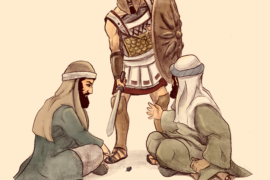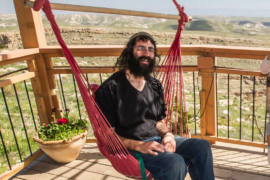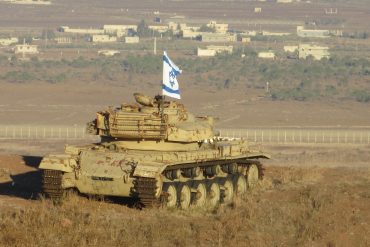Parshat Pekudei concludes the Book of Sh’mot with the consecration and inauguration of the Mishkan.
In what way does the Sinai Covenant serve us as a ladder to transcend this world?
Why was it Moshe and not Aharon who consecrated the Mishkan?
In what way do the final three Books of the Torah continue separate but parallel themes featured in Sefer Sh’mot?
“The Hebrew Identity” podcast draws upon teachings from Manitou (Rav Yehuda Ashkenazi), Rav Kook, and many of Israel’s ancient sages to present the evolving story of the Hebrew tribes, as seen in the weekly Torah portion. The series focuses on what the unique challenges and personal growth of various Biblical personalities can teach us about our present day struggles.
For more content from VISION Magazine, subscribe to our newsletter and follow us on Twitter @VISION_Mag_, Facebook and YouTube. If you haven’t already, don’t forget to subscribe to our podcast on SoundCloud, iTunes, Stitcher, TuneIn, or Spotify and leave a rating and review to help us get our message out to a wider audience!
To support the podcast, head over to our PayPal portal and be sure to write a note that your contribution is for the podcast.
Hosted by: Yehuda HaKohen
Transcript:
Parshat Pekudei brings us to the end of Sefer Sh’mot. What began with the tribes of Israel being enslaved and ultimately liberated from Egypt concludes with receiving the Torah and constructing the Mishkan.
It’s important to recognize the advancement that took place over the course of Sefer Sh’mot. Not only the personal advancement of Moshe, whose connection with the children of Israel was initially very weak but gradually strengthened, but also the collective advancement of the entire people.
The Brit Avot that the Creator had established with the ancestors in Sefer B’reishit focused primarily on ideals, which is appropriate at the level of a family.
But this was supplemented in Sefer Sh’mot with the Brit Sinai – a Divine legal code to govern the conduct of a nation dealing with all of the worldly issues and challenges that nations are generally forced to contend with.
The word Sinai shares a numerical value of 130 with the word “sulam” – which translates into English as “ladder.” The Brit Sinai should be understood as a ladder in the form of a legal code offering us a means to transcend beyond this world’s ostensible limitations.
Parshat Pekudei opens with an accounting of the materials that had been donated to build the Mishkan. Itamar ben Aharon HaKohen led the tribe of Levi in taking this accounting.
We then see the creation of the uniforms of Aharon and his sons who will soon be officially consecrated as Israel’s kohanim, responsible to cleanse the people from transgressions and inspire them towards living according to the laws of the Brit Sinai and the ideals of the Brit Avot.
As we discussed in our episode on Parshat Tetzave, all of the garments of the kohanim are specially designed to have an inspirational effect on the people witnessing the service.
Moshe first directed the people to build the Mishkan on the eleventh day of the month of Tishrei, one day after he had returned from Sinai together with the stone tablets and a scroll of Divine laws.
Nearly half a year later, on the first of Nisan – just two weeks before the first anniversary of our leaving Egypt – the work was finally completed and the Mishkan was ready for inauguration.
The components of the Mishkan were brought to Moshe for assembly because even though the construction was a collective endeavor of the people, only Moshe could assemble the pieces together and consecrate the Tabernacle for use.
Moshe consecrated the various parts of the Mishkan with the olive oil specially designated for anointment. He also dressed Aharon and his sons in their uniforms and consecrated them with the anointment oil as well because, in a sense, Aharon and his sons were also utensils of the Mishkan.
Although Aharon was the High Priest, Moshe served as what we can understand to be a “Super Priest” responsible for consecrating the kohanim. Sh’mot 40, verse 31 even shows Moshe acting as a priest – washing his hands and his feet together with Aharon and his sons.
During the inaugural service of the Mishkan, Aharon appears to have served as Moshe’s deputy. We see in Sh’mot 40, verse 25, that it was Moshe who first lit the Menora. And we see in verse 27 that it was also Moshe who first burned the incense. But from then on, Aharon and his descendants would be continuing the avoda initiated by Moshe.
Just as the ḥakhamim continue to engage and interact with the Torah on our behalf through a process began by Moshe, so do the kohanim also continue work Moshe started.
Once the Mishkan had been assembled and consecrated, the Divine Presence filled it in the form of a cloud. When the cloud would remain in the Tabernacle, the children of Israel would remain in place but when the cloud would lift, the Hebrews would continue the journey towards the promised land of the ancestors.
The next two Books of the Torah, Vayikra and Bamidbar, should be understood not as chronologically successive but rather as showing us two different but largely parallel experiences Israel had in the desert that are each progressions of different themes featured in Sefer Sh’mot.
Vayikra for the most part shows us when the cloud would fill the Mishkan and Moshe would be invited inside to continue learning the Torah – especially the laws pertaining to the responsibilities of the kohanim. This Book continues the theme of the Divine Presence among Israel that Sefer Sh’mot ends with and focuses primarily on the priestly service and with the laws associated with kedusha and tahara – holiness and purity.
Sefer Bamidbar, by contrast, continues the theme of our people’s story that Sefer Sh’mot began with and focuses on Israel’s continued national development – essentially what occurred when the cloud would lift and the Hebrews would advance in our journey towards the promised land.
The fifth Book of the Torah, D’varim, continues the theme of the Brit Sinai that bridges the other two themes in Sefer Sh’mot and focuses on the realization of that covenant once we were to enter the Land of Israel.




